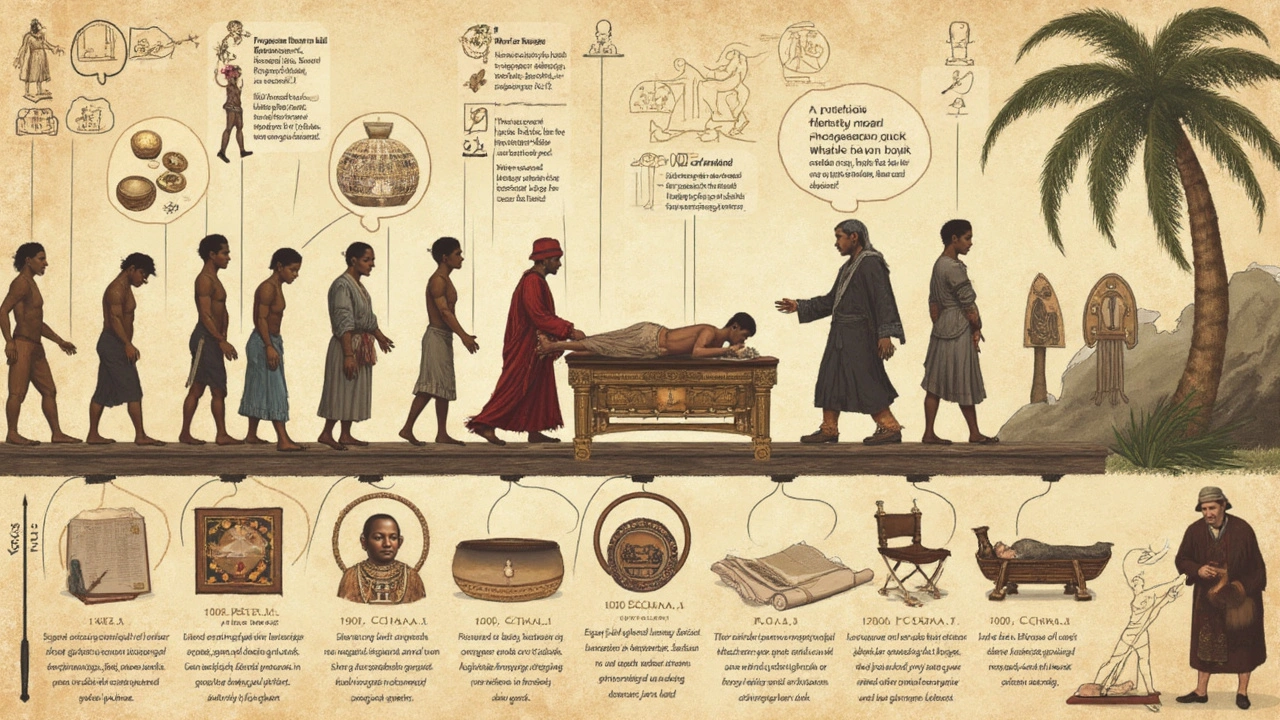History and Evolution of the Massage Therapist Profession: From Ancient Roots to Modern Practice

You’d be surprised at just how far back massage therapy goes. We’re not talking a couple of centuries—try thousands of years. People have used touch for healing since the times of pharaohs, yogis, and gladiators. Yet, even with its ancient roots, the profession of the massage therapist only really started to look like what we see today in the last century or so.
If you’re looking for a practical path to feeling better, understanding where massage came from actually helps. Knowing what goes into becoming a therapist tells you a lot about what to expect from a session, too. It’s more than just a back rub; it’s a blend of old-school tradition and modern science, all focused on getting you real results. Fun fact—some early Olympic athletes got massages before events, kind of like pro sports teams do now.
- Key Takeaways
- What Is a Massage Therapist?
- How Did the Massage Profession Begin?
- Massage Styles and Where to Find Them
- What Happens During a Massage Session?
- Safety, Price, and Booking Tips
Key Takeaways
Here’s what stands out about the massage therapist profession if you want the facts without the fluff:
- The roots of massage therapy stretch back over 4,000 years, with strong evidence in Ancient China, Egypt, and Greece. They actually used massage as both medicine and relaxation back then.
- The job of the modern massage therapist really kicked off in the late 1800s and early 1900s, as scientific research began backing its health benefits. Before that, it was more of a tradition than a profession.
- Today, there are more than 350,000 licensed massage therapists in the U.S. alone. The number keeps growing thanks to increasing demand for stress relief, injury recovery, and wellness.
- You’ll find dozens of styles now—think deep tissue, Swedish, sports, and even hot stone. Each one comes with its own set of benefits. Some are great for relaxation; others target pain or help sports performance.
- Getting a massage isn’t just a luxury. Modern studies link it to real benefits like better sleep, reduced anxiety, pain relief, and speedier recovery from muscle injuries.
- The cost is pretty wide-ranging, but on average expect to pay $60–$120 for a session in most urban areas. A little more in upscale clinics; a bit less if you go local or student-run.
| Year | Estimated U.S. Practitioners | Common Techniques |
|---|---|---|
| 1900 | Under 1,000 | Swedish, Ancient Eastern |
| 2000 | ~120,000 | Swedish, Deep Tissue, Shiatsu |
| 2024 | 350,000+ | Swedish, Sports, Thai, Trigger Point, and more |
If you’re thinking about booking a massage, it’s not just about pampering. The massage history and its science-backed results make it worth considering for real health benefits, not just a rare treat.
What Is a Massage Therapist?
A massage therapist is a trained professional who helps relieve pain, stress, and muscle tension using a range of hands-on techniques. This isn’t just squeezing shoulders. Most therapists go through hundreds of hours of learning about anatomy, physiology, and even ethics before they can see clients legally.
Typically, a massage therapist’s job involves:
- Assessing your health needs before starting
- Listening to any aches or problem spots you mention
- Using specific movements and pressure to work sore muscles, speed up healing, or boost relaxation
- Advising you on stretches or self-care to keep the benefits going
In the United States, therapists usually need a state license after completing an accredited school program. The average program lasts around 500 to 1,000 hours. Most states also require a national exam before you can officially call yourself a massage therapist. That's why you want to see someone legit, not just anyone with "magic hands" at a gym.
Massage therapists work in lots of places: private studios, health clinics, spas, even hospitals or sports teams. About half work as independent contractors, setting their own hours and building repeat clients. Here’s a quick look at the field:
| Where You’ll Find Them | What They Focus On |
|---|---|
| Spas | Relaxation, stress relief |
| Medical Clinics | Pain management, injury rehab |
| Sports Facilities | Muscle recovery, peak performance |
| Hotels | Travel relaxation, quick sessions |
The bottom line? A massage therapist blends technical skill and people skills, making every session feel personal. If you’ve ever wanted a career that’s hands-on, literally, and helps people feel better, this is one of the few jobs that checks all those boxes.
How Did the Massage Profession Begin?
The roots of the massage therapist profession go way back, even before most people were writing things down. In ancient China, early forms of massage show up in medical texts from around 2700 BCE. Those old Chinese records talk about using hand techniques to treat injuries and help the body heal. Over in India, traditional Ayurvedic massage also dates back more than 3,000 years, focusing on balancing the body’s energy systems.
The Greeks and Romans took things even further. Hippocrates, who’s kind of the father of modern medicine, was all about “rubbing” as a part of medicine around 400 BCE. Gladiators even had special massage therapists to keep them ready for battle and help them heal afterward. Roman baths often featured massages, making it a standard part of public life for those who could afford it.
Fast forward to the medieval period, and things got a bit rocky for massage in Europe. There was less focus on the body, and many old practices faded for a while. But not everywhere—massage stayed strong in China, India, and parts of the Middle East.
The real comeback in Europe kicked off in the 1800s with a Swedish guy named Per Henrik Ling. He developed what we now call Swedish massage. His techniques mixed science with traditional moves, and suddenly, massage therapist training started looking pretty official. By the late 1800s, massage schools began popping up in Europe and North America, and it was finally seen as a legit career path.
Here’s how the profession transformed over time:
- Ancient Times: Healing hands in China, India, Egypt, Greece, and Rome.
- Middle Ages: Popular in the East, but lost ground in Europe.
- 19th Century: Swedish massage introduced formal techniques and training.
- 20th Century: Massage therapy enters hospitals, spas, and sports teams in the US and beyond.
Today, becoming a massage therapist involves schooling, hands-on practice, and passing state or national exams. Here’s a cool stat to chew on: According to the American Massage Therapy Association, over 47,000 massage therapists are certified every year in the USA. Not bad for a field that started in ancient temples and battlegrounds.

Massage Styles and Where to Find Them
When you think of a massage therapist, you might picture a dimly lit room, scented oils, and soothing music. But there’s way more to it. The world of massage therapist work is packed with options, each with its own roots and benefits. Here’s a quick breakdown of the most popular types:
- Swedish Massage: This is the classic. If you’ve ever had a massage at a spa, it was probably a Swedish massage. It uses long strokes, kneading, and gentle tapping to relax your muscles and boost blood flow.
- Deep Tissue Massage: Got a knot in your back that won’t quit? Deep tissue targets those really stubborn spots. Therapists use slow, firm pressure to go deeper into muscle layers. Great for chronic tension.
- Sports Massage: Athletes swear by this style. Sports massage helps prevent and recover from injuries by focusing on muscles that get worked hardest. Even if you’re not a pro, it’s handy after a weekend workout.
- Thai Massage: This isn’t just lying on a table. You’re stretched and moved through different positions—so it’s kind of like yoga with a hands-on coach. It’s been used in Thailand for over 2,500 years.
- Hot Stone Massage: Warm stones are placed on your body and used for massaging. They help loosen up tight muscles fast and feel pretty amazing, especially in winter.
- Reflexology: Focuses on your feet, hands, or ears. Therapists believe these spots connect to the rest of your body. Many people use it for stress or headaches.
A survey by the American Massage Therapy Association (AMTA) found that in 2023, over 47.5 million Americans got a professional massage—that’s a lot of tense shoulders getting relief. You’re not alone if you want to try it.
“Massage is much more than a luxury; it’s a powerful tool for health and wellness.” – American Massage Therapy Association
So, where do you find a massage therapist offering these styles? Most cities have options for all budgets. Here’s what works:
- Day spas often cover Swedish, deep tissue, and hot stone massages.
- Sports clinics and physical therapy centers focus on sports and deep tissue work, especially for specific injuries.
- Chiropractic offices and wellness centers sometimes mix massage with chiropractic care.
- For Thai or reflexology, look for specialized studios or practitioners in cultural neighborhoods—many have training straight from Thailand or China.
- Mobile massage therapists now come to you, perfect if you want privacy or can’t travel.
Don’t forget to check out online reviews before you book, and see if the therapist is licensed—most state boards have easy lookup tools. Asking about their training and specialty isn’t rude, it’s smart. Some places even offer a short consultation to match you with the right type of massage for your needs.
Here’s a handy table to compare a couple of common types and where to find them:
| Massage Type | Best For | Where To Go |
|---|---|---|
| Swedish | Relaxation, stress relief | Day spa, wellness center |
| Deep Tissue | Chronic muscle pain | Sports clinic, physical therapist |
| Thai | Flexibility, energy | Thai studio, some spas |
| Hot Stone | Stiffness, muscle tension | Day spa |
| Reflexology | Foot pain, headaches | Reflexology studio, wellness center |
With all these choices, you don’t have to settle for anything generic. Explore the styles, hunt for a pro who matches your vibe, and you’ll get the most out of every session.
What Happens During a Massage Session?
Walking into a massage therapist’s office can feel a little mysterious, especially if it’s your first time. You might be wondering if you have to take your shoes off right away, or if you’re supposed to talk during the session. Here’s the lowdown so you know exactly what to expect and can just focus on relaxing.
First, your therapist will ask a few questions about your health, any injuries, and what you’re hoping to get out of the session. Don’t be shy—this is the time to mention if you have sore shoulders from too many hours at the desk or if you just need to de-stress. They’ll go over the method they plan to use, whether that’s Swedish, deep tissue, or something fancier like shiatsu. If you’re not sure what style fits your needs, ask! They expect it.
Next, you’ll be shown to a private space to undress to your comfort level. Some people keep underwear on, some don’t—there’s really no right or wrong; you’ll be covered by a sheet at all times anyway. After you’re set up on the table, under the blanket, the session begins. Most sessions start with gentle touch to help you get used to it, then move into firmer pressure, working out knots and tension in your muscles. Massage oils or lotions are usually used to stop friction and help with the technique.
| Step | Details |
|---|---|
| 1. Intake & Questions | Share your health history and goals |
| 2. Dressing Down | Undress privately to your comfort level |
| 3. On the Table | Lie under a sheet/blanket provided |
| 4. Session Begins | Therapist uses chosen massage style |
| 5. Feedback | You can ask for more/less pressure anytime |
| 6. Finish & Aftercare | Time to slowly get up, hydrate, and discuss tips |
Open communication is key. If the pressure is too light or too rough, let them know. A great massage therapist wants you to get the most out of your time. As Dr. Tiffany Field from the Touch Research Institute puts it:
“The best results come when clients speak up about what they like and what’s uncomfortable. It’s a team effort.”
Most sessions run between 50 and 90 minutes. Afterward, you’ll get time to slowly sit up, put your clothes back on, and talk about how you feel or get quick at-home tips to keep that relaxed feeling going. If you feel a little groggy after—don’t freak out. That’s just your body letting go of stress.
And hey, the golden rule: drink plenty of water after your session. It really does help flush out all that stuff your muscles just released.
Safety, Price, and Booking Tips
If you’re booking your first session with a massage therapist, safety’s a biggie. Always make sure your therapist is certified. In the US, therapists usually need a license, so ask to see it or check their credentials online. It’s totally normal, and any pro will gladly show you. Also, let your therapist know about any injuries or medical conditions, especially before deep tissue work. If something feels off—like pain or discomfort—speak up right away. A good therapist will adjust right away.
Next up: price. Massage costs can really vary depending on where you live, the type of massage you’re after, and how long your session lasts. The average price in most US cities is between $70 and $120 for a one-hour session. Luxury spas charge more, while smaller, independent studios are usually budget-friendlier. Here’s a snapshot, just so you know what to expect:
| Type of Massage | Average Cost (1 Hour) |
|---|---|
| Swedish/Classic | $70 – $100 |
| Deep Tissue | $80 – $120 |
| Sports Massage | $90 – $130 |
| Hot Stone | $100 – $140 |
Watch out for deals and package offers, too—some places throw in the sixth massage free if you buy a bundle upfront.
Ready to book? Most therapists offer easy online booking, but calling directly sometimes lands you a better time slot. To snag a spot with a sought-after therapist during busy seasons (think: right after holidays or during winter), book a week in advance. And don’t forget to check reviews on Google or Yelp before you commit. Look for comments about professionalism, cleanliness, and overall experience—these tell you a lot.
Before heading to your appointment, drink some water and arrive at least ten minutes early. That gives you time to fill out forms and chat with your massage therapist about what you want. Trust your gut; if anything feels sketchy, it’s okay to walk away.
- Always ask about therapist credentials
- Be clear about your comfort or pain levels
- Check for clear prices upfront—no surprises
- Book early for prime times and top professionals
- Look over reviews for red flags
Prioritizing safety, knowing prices, and booking smart means you get the best out of your massage therapist experience. Treat it like any other important service—do a little homework, and your body will thank you later.



